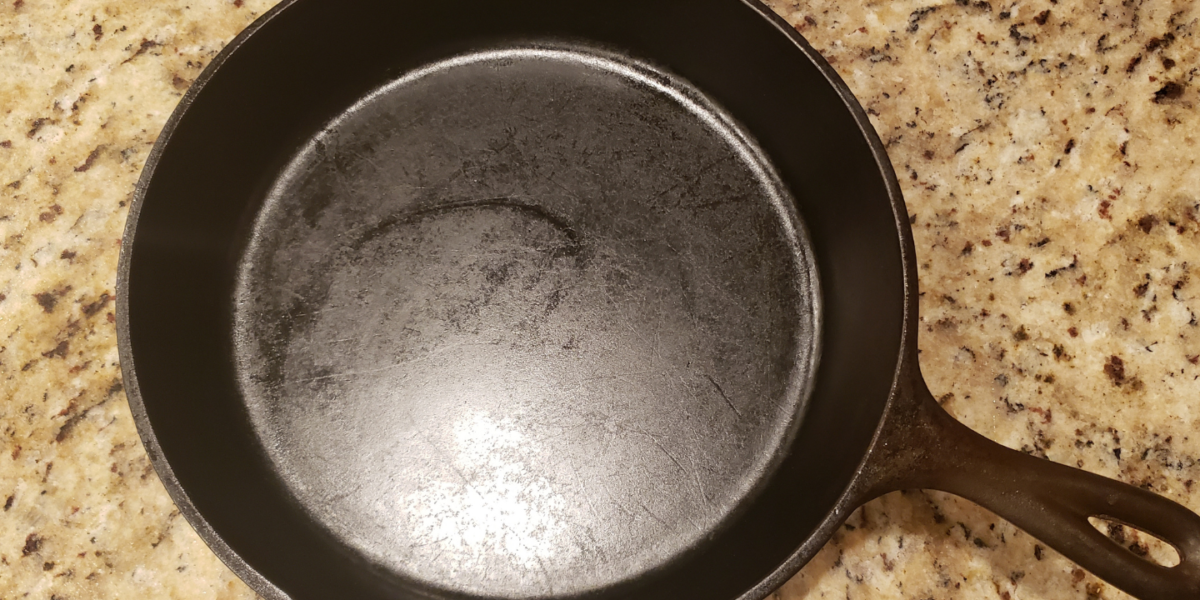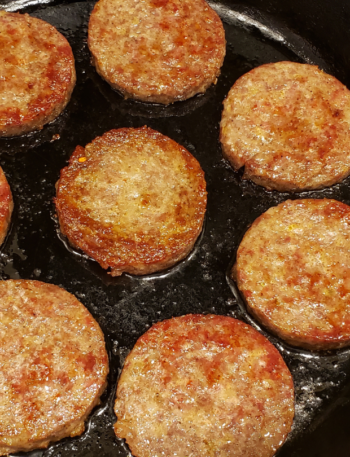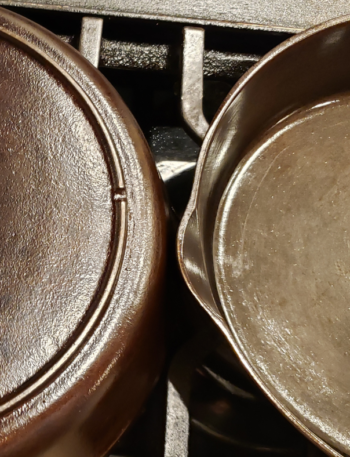Before you use your cast iron pan, there are a couple of things you have to do. First, wash it, then season it. Seasoning it will coat the cast iron in a polymerized fat that will act as a barrier between the metal and the food you cook in it.
There are many blogs and videos about how to season your cast iron. But there are a few simple tricks you can do to get the perfect seasoning on your cast iron.
- 5 Best Fats for Seasoning Cast Iron
- How do you season cast iron?
- FAQs
- Can I use my cast iron right after seasoning?
- How often do you season cast iron?
- What temperature do you season cast iron?
- Can I remove the factory seasoning and reseason my cast iron?
- Do you put oil on cast iron after seasoning?
- Should you not boil water in cast iron?
- Is it OK to spray Pam on cast iron?
- Should I season cast iron at 350 or 450?
- Does it matter if the bottom of cast iron is rusty?
- Why shouldn’t you season cast iron with olive oil?
- Can you oil cast iron too much?
- How do you season a cast iron skillet on the stove?
- How many coats of seasoning should you put on cast iron?
- Should you remove rust before seasoning cast iron?
- Do you have to remove old seasoning from cast iron?
- How do you know if cast iron is seasoned enough?
- Conclusion
First, you will need a heat source such as an oven or stovetop. You will need to get your cast iron cookware very hot, somewhere between 400-500 degrees.
Secondly, you will need an edible fat to coat the cast iron. I will list my recommendations in order of preference and then discuss the pros and cons of each in more detail.
5 Best Fats for Seasoning Cast Iron
Order of fat preference to season cast iron cookware.
- Beef tallow (rendered from organ fat, around the kidneys)
- Beef fat (rendered beef muscle fat)
- Lard (rendered pork fat)
- Avocado Oil
- Grapeseed Oil
Don’t even bother with other oils. I’m serious. You will get poor results and you will blame the cast iron, or worse, me.
I recommend the beef tallow or beef fat. Tallow is more difficult to get and more expensive. You will be fine with beef fat. When you season with this fat you get an excellent seasoning coat. You would swear it is a hard plastic coating. You will love how well you can cook items in the pan with no sticking.
Lard is my second choice. It is another saturated fat that is a solid when at room temperature. It works nicely to season the cast iron and is much more readily available.
If you are not using beef or pork fat, then I recommend avocado oil or grapeseed oil. They both have high smoke points so they can withstand the heat of the seasoning process without adding any burnt oil flavor to the cast iron. You will see recommendations to use vegetable oil and soybean oil but don’t do that to your cast iron.
Your cast iron is an investment, why not do things properly to set it up for years of fantastic cooking? Below is a Q&A on the common questions asked about seasoning cast iron cookware.
Take a look at my Resources page to see some different options for cast iron cookware
Affiliate Disclosure: This post contains Amazon affiliate links. When you buy any product using the links below, I get commissions. But it doesn’t cost you anything extra. If you do purchase any product using the given links, we thank you in advance! As an Amazon associate I earn from qualifying purchases.
How do you season cast iron?
The process of seasoning is quite simple but requires a little patience. Here are the steps:
- Preheat oven to 450-500 degrees Fahrenheit.
- Gently wash the pan in warm water with a mild detergent like Dawn.
- Rinse clean and do not let it sit wet – go to steps 4 and 5 immediately.
- Dry with a paper towel or clean kitchen cloth.
- Heat the pan on the stovetop so that it is too hot to touch.
- Lightly coat the entire hot pan with the fat you’ve chosen for seasoning – cover the handle, bottom, and sides as well. Be careful, the pan is dangerously hot at this point.
- Place hot coated pan into the oven on the middle rack for 1 hour.
- After 1 hour, turn the oven off and let the pan cool to room temperature.


Repeat steps 5-8 about 4 more times. This can be done over days. It doesn’t have to be done all in the same day. If you want to use the pan while you are in the process of seasoning it, you can fry in/on it during the seasoning process. This will enhance the seasoning process. Every time you fry with it, you are essentially repeating the oven process on the stovetop.
This will give you a good starter coat of seasoning. From this point forward you want to cook as much as you can with the pan using your chosen cooking fat. I use beef fat for best results.
Related Posts
FAQs
Can I use my cast iron right after seasoning?
Yes, you can use your cast iron right after seasoning and you should. In fact, you should cook every meal with it for a couple of weeks. You will see how well the seasoning develops with the constant cooking.
How often do you season cast iron?
It all depends on usage frequency and storage conditions. I season my cast iron after each use/cleaning, which is 1-3 times daily. Not seasoning it after each use is simply poor maintenance.
You do not have to heat it in the oven for an hour after each use but use the stovetop to heat the pan to a smoking point, burn off the water, and then apply a light coating of beef fat or other recommended fats from above. Be careful when doing this, the oil will get as hot as the pan. I use a paper towel to spread about a tablespoon of oil all over the pan. I cover the pan, handle, and bottom of the pan.
What temperature do you season cast iron?
You should season your cast iron at a temperature of 400-500 degrees Fahrenheit. Lodge recommends 450-500. If your oven is not hot enough, you will not achieve the polymerization process you are trying to apply.
Can I remove the factory seasoning and reseason my cast iron?
Yes, you can remove the factory seasoning. I refinish cast iron by using Easy-Off oven cleaner. It will strip your cast iron cookware down to the cast iron, at which point you can reseason it properly. Learn more about how to recondition or reseason a cast iron pan.
Do you put oil on cast iron after seasoning?
Yes, putting oil in the pan is a part of the seasoning process. The purpose of the oil is to create a carbonized coating on the pan. When the pours of the metal expand, they absorb the oil creating a smooth surface. To solidify this smooth coating the oil should be heated for about an hour between 400-500 degrees.
Should you not boil water in cast iron?
Ideally, you should not use your cast iron to boil water or to cook water-based foods. Cast iron cookware is best suited for foods that need to be cooked in fat. If you need to boil water or cook water foods such as sauces and soups, stainless steel is your best option.
Is it OK to spray Pam on cast iron?
You can use it to cook on a seasoned cast iron skillet, but why use it when there are much better fats to use for the food? Do not season your cast iron with it. Learn more about how to properly season your cast iron cookware.
Should I season cast iron at 350 or 450?
You should season your cast iron at 450-500. Most conventional ovens will get that hot, so turn it up just a little bit higher the achieve the best results.
Does it matter if the bottom of cast iron is rusty?
Yes, it does. Letting the bottom get rusty can cause damage to the surface of the cast iron. There is no need to let that happen, but if it does, simply scrub the rusted spot with a copper scrub pad and reseason when over the stovetop. Simply get the pan- hot, apply the fat on the previously rusted spot, and let it stay hot for a few minutes. This should fix the problem after a few times.
Why shouldn’t you season cast iron with olive oil?
Olive oil has a very low smoke point and should not be used to season cast iron. The smoke point is the temperature when the burning oil will start to smoke. The burnt oil will create a foul taste in the pan. You will be much happier with the proper fat, beef fat, or avocado oil.
Can you oil cast iron too much?
You can put too much oil on your cast iron when seasoning it. If you have excess, it will solidify in interesting patterns on the surface of the cast iron and become gummy or sticky. It is not the kind of finish you are trying to achieve. If this happens, let the pan cool and simply scrub the surface with a copper scrub pad in a circular motion under warm water. You will see the surface start to level out and become smooth again. Be careful not to take all of the fat off. Re-season the pan again, rub a light coat of fat on the pan, and let it cook in the oven for an hour at 400-500 degrees.
How do you season a cast iron skillet on the stove?
The process of seasoning is almost the same as the oven method. Here are the steps:
- Gently wash the pan in warm water with a mild detergent like Dawn.
- Rinse clean and do not let it sit wet – go to steps 4 and 5 immediately.
- Dry with a paper towel or clean kitchen cloth.
- Heat the pan on the stovetop so that it is too hot to touch.
- Lightly coat the entire hot pan with the fat you’ve chosen for seasoning – cover the handle, bottom, and sides as well. Be careful, the pan is dangerously hot at this point.
- Heat the pan just until it starts to smoke. If you let it get hotter, it will fill your house with smoke. You may need to turn the temperature down to low depending on which burner you use and the output of your stove. The best control method is with the thermometer.
- Once it starts to smoke, turn the burner off and let the pan cool to room temperature.
- Repeat steps 4-7 about 4 more times.
How many coats of seasoning should you put on cast iron?
You should put about 4-5 coats of seasoning on your cast iron before using it with wet foods. If you are going to fry in/on it repeatedly, then you can start with 3. Remember, the more coats you put on the more effective they will be.
Don’t get carried away and put more than 5 because you will be wasting your time. Cooking fried foods on it after the seasoning will help with the seasoning process.
Should you remove rust before seasoning cast iron?
You should always remove rust from cast iron before seasoning. I use a copper scrub pad to clean my new/vintage pans before seasoning. Copper is a soft metal that scours rough surfaces. I would not recommend a copper scrub pad as a daily cleaning pad. Just use it in circumstances such as rust on the pan, sticky build-up of oils, or when re-seasoning.
Do you have to remove old seasoning from cast iron?
A well-seasoned cast iron pan will be useful for years, maybe decades, depending on how you cook in it and what you in it. It will also depend on how well you maintain it after each use. If cook properly in it by not getting it too hot, avoid using your cast iron to cook acidic foods, and you give it a quick stove top reseason after cleaning, then you will enjoy years of great use before you even have to think about removing the old seasoning and re-seasoning it.
How do you know if cast iron is seasoned enough?
The best test to give your cast iron cookware for proper seasoning is frying an egg in it. If your egg does not stick, then your pan is seasoned enough.
Conclusion
Seasoning your cast iron is the best way to preserve it and have cooking success. Some of the newer cast iron pans come with a facotry baked seasoning on them. I understand why they do this, since most people don’t want to season their pans properly. but I’m not sure I’m on board with it.
Discover more from In The Kitchen With Vic
Subscribe to get the latest posts sent to your email.






